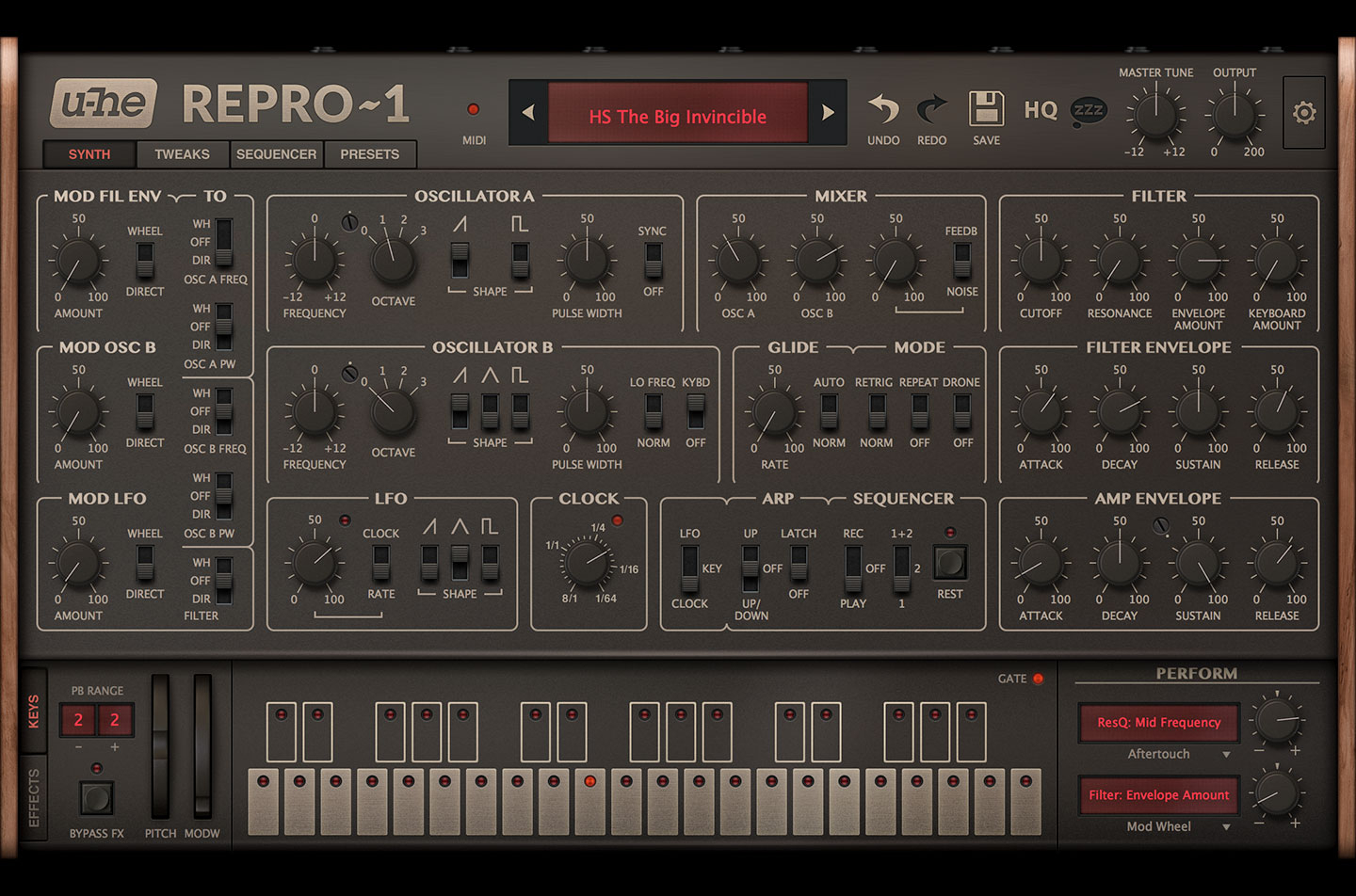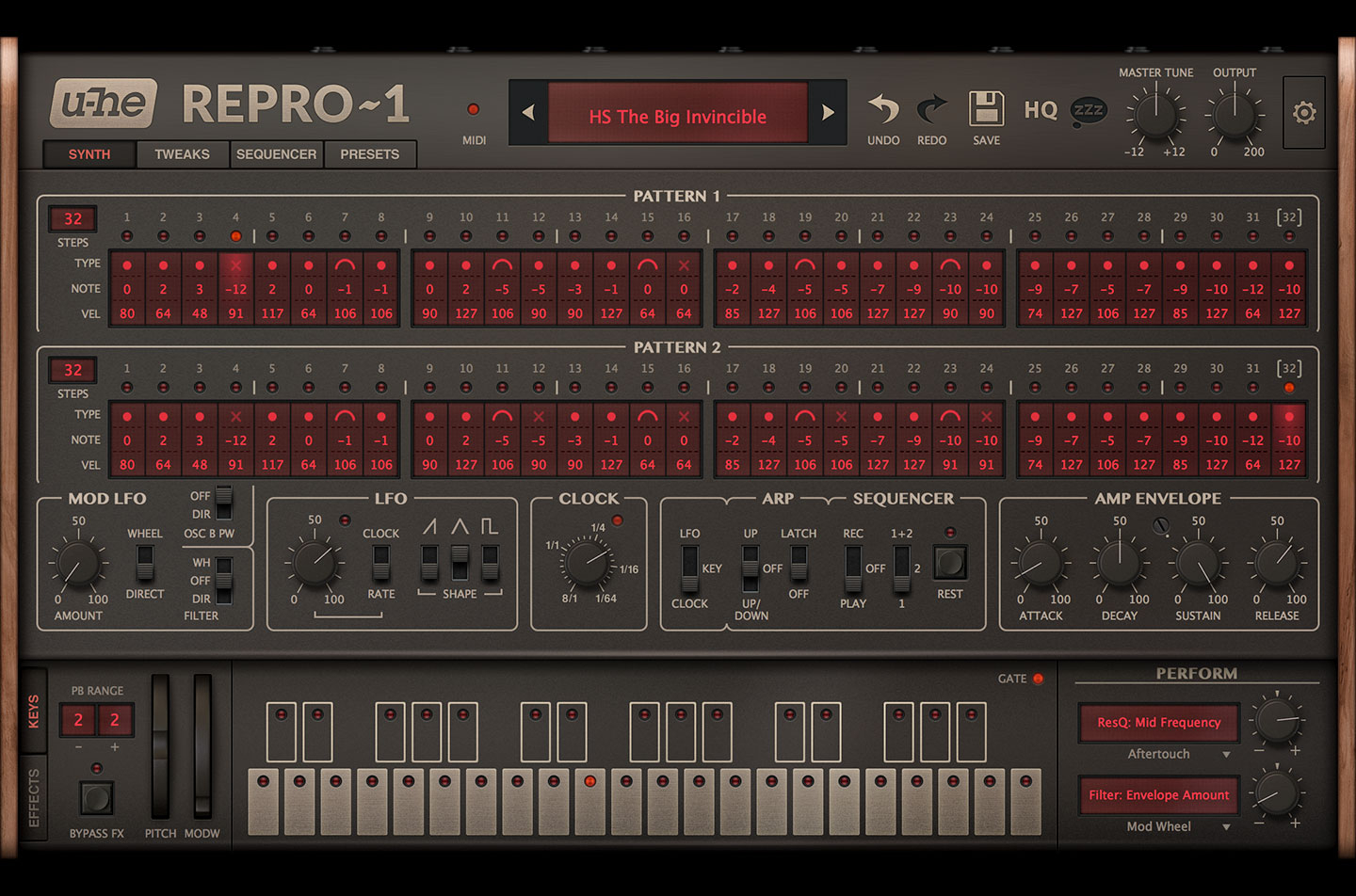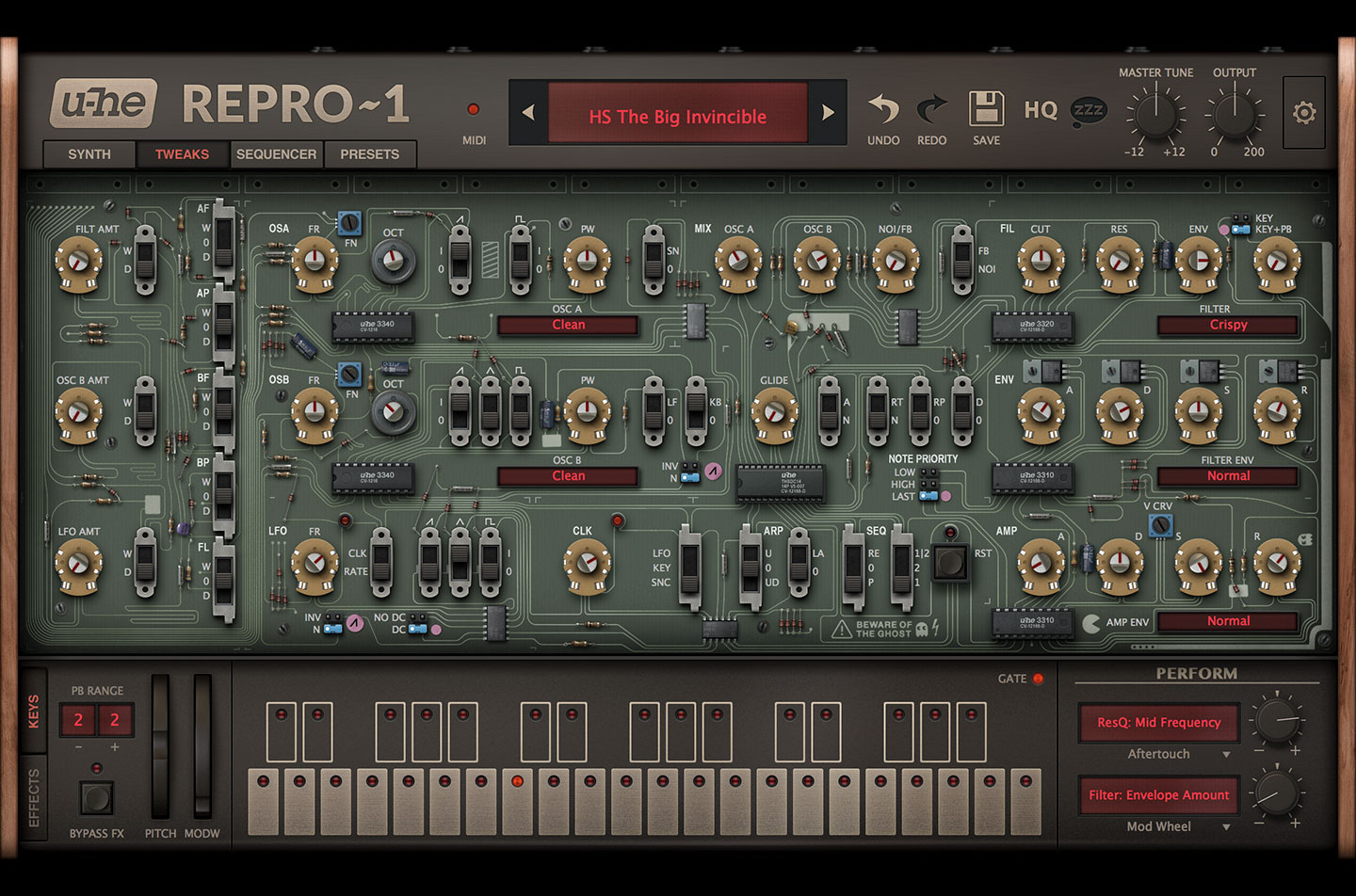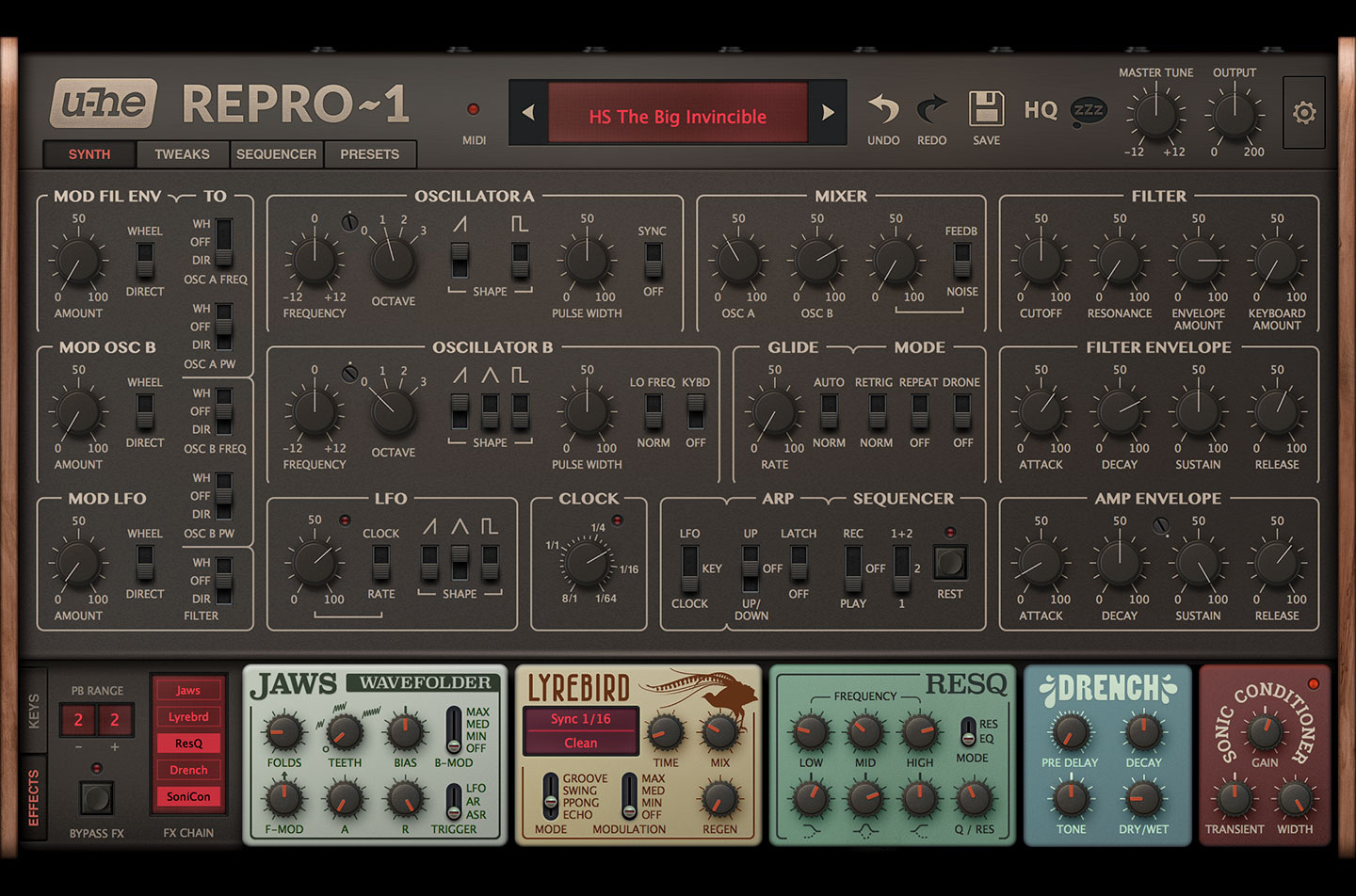- Compared to its better-known contemporaries, the Sequential Circuits Pro-One is often overlooked. This may be due to the fact that many assumed it to be nothing more than a monophonic version of the Prophet-5. But thanks to a built-in sequencer and relatively advanced modulation possibilities, the Pro-One held its own and made a mark on records by artists like Depeche Mode, New Order, Ed Rush and Carl Craig. Another potential factor leading to its lack of widespread exposure was the limited quantity of units—around 10,000—produced during its three-year run in the early '80s. A modern side effect of limited production is that the original hardware is notoriously difficult to get your hands on. This makes it even more surprising that there have been few virtual recreations of the Pro-One produced by the big names in music software. That is, until this past December, when the Berlin-based software synth specialists at u-he released their latest product, the Repro-1.
u-he are the creators of Diva, the successful softsynth released in 2011 that recreated the behaviour of individual components of famous synthesisers from Moog, Roland and Korg. While other developers have followed suit (notably Roland with its ACB technology), this was a somewhat revolutionary approach at the time. The result was a native plug-in that sounded as close to the original hardware as software could feasibly get. The team at u-he reportedly applied the lessons and skills they developed with Diva to the Repro-1, comparing and measuring different individual instruments to make sure every nuance of the Pro-One was covered.
The main UI for Repro-1 shows just how faithfully the team held to the design of the physical instrument. Barring one minor exception, you'll find the same control layout as the hardware on the main Synth page. This was a wise design decision, as the Pro-One's control scheme was artfully laid out and served as inspiration for many modern synth designs. There aren't many surprises to be found here: you've got two oscillators, of which the first can be sync'd to the second, while the second can be converted to a secondary LFO. From there the signal passes into the mixer, which allows you to add noise or feedback, and then through a four-pole low-pass filter before ending up in the amplifier for output.
When it comes to modulation, the Repro-1 largely sticks to the original. Three sources, namely the dedicated LFO, oscillator B, and the filter envelope, can be assigned to five destinations such as oscillator frequency, pulse-width and filter cutoff. This connection can be made directly or based on modwheel position via the same panel layout found on the Pro-One. This panel design, with its odd dividing lines, switches with abbreviations and generally vague positioning can be tough for new users to get their head around. However, with a bit of practice (the manual suggests a "few hours") it's quite simple to use. If this were the limit of Repro-1's mod capabilities, it would be a bit of a disappointment. Thankfully, u-he and team added another pair of modulation paths in the Perform section, where you can assign other sources—including velocity and aftertouch—to essentially any control on the instrument. This is a useful addition that extends Repro-1's flexibility well beyond the original hardware, and while two extra sources are probably enough for many, I would have liked to have more at my disposal.
The Pro-One came equipped with a rudimentary sequencer that was a brilliant bit of engineering for its time. Thankfully though, this is one aspect of the original instrument where the Repro-1 diverges to take advantage of the much greater flexibility afforded by the computer. The sequencer here allows you to record two separate patterns of 32 velocity-sensitive steps each with ties and rests supported. On the original, the sequencer was locked to the LFO tempo but the Repro-1 offers a choice between LFO, manual key progression and a separate host-synced clock. The addition of the clock knob is the lone difference on the front panel.
The final tools in Repro-1's kit are dedicated to massaging the sound in both subtle and extreme ways. The subtle can be found in the Tweaks panel, which lifts the lid of the instrument to expose a circuit board display where you can make unabashedly geeky adjustments like inverting LFO waveforms or changing the flavour of the oscillator, filter and envelopes. On the other side of the coin, you can make much more extreme alterations in the Effects panel. Here you'll find a set of five stompboxes that can be enabled or disabled as well as rearranged freely. These include a wavefolder, a bucket-brigade delay, a resonator/equaliser, a reverb and a sonic conditioner. Such a combination allows you to really transform the already impressive sound of the Pro-One into something colossal.
Repro-1 achieved the rare feat of leaving me with nothing substantial to wish for outside of the very minor desire to have more modulation slots at hand. The plug-in simply sounds incredible, and unlike Diva at its initial release, the CPU utilisation is (relatively speaking) pretty manageable, thanks to optimisations made by the u-he team during pre-release testing periods. I had more than one "wow" moment when rolling through the excellent preset library, which does a great job of showing off the instrument's potential. And if you own Native Instruments Maschine or Kontrol Keyboards, the presets take on even greater value thanks to support for Native Instruments' NKS format. If you're looking for a pristine recreation of vintage analogue in a plug-in form, there's possibly no better value for your money available right now.
Ratings:
Cost: 4.6
Versatility: 4.0
Ease of use: 4.0
Sound: 4.5
 The Pro-One came equipped with a rudimentary sequencer that was a brilliant bit of engineering for its time. Thankfully though, this is one aspect of the original instrument where the Repro-1 diverges to take advantage of the much greater flexibility afforded by the computer. The sequencer here allows you to record two separate patterns of 32 velocity-sensitive steps each with ties and rests supported. On the original, the sequencer was locked to the LFO tempo but the Repro-1 offers a choice between LFO, manual key progression and a separate host-synced clock. The addition of the clock knob is the lone difference on the front panel.
The Pro-One came equipped with a rudimentary sequencer that was a brilliant bit of engineering for its time. Thankfully though, this is one aspect of the original instrument where the Repro-1 diverges to take advantage of the much greater flexibility afforded by the computer. The sequencer here allows you to record two separate patterns of 32 velocity-sensitive steps each with ties and rests supported. On the original, the sequencer was locked to the LFO tempo but the Repro-1 offers a choice between LFO, manual key progression and a separate host-synced clock. The addition of the clock knob is the lone difference on the front panel. The final tools in Repro-1's kit are dedicated to massaging the sound in both subtle and extreme ways. The subtle can be found in the Tweaks panel, which lifts the lid of the instrument to expose a circuit board display where you can make unabashedly geeky adjustments like inverting LFO waveforms or changing the flavour of the oscillator, filter and envelopes. On the other side of the coin, you can make much more extreme alterations in the Effects panel. Here you'll find a set of five stompboxes that can be enabled or disabled as well as rearranged freely. These include a wavefolder, a bucket-brigade delay, a resonator/equaliser, a reverb and a sonic conditioner. Such a combination allows you to really transform the already impressive sound of the Pro-One into something colossal.
The final tools in Repro-1's kit are dedicated to massaging the sound in both subtle and extreme ways. The subtle can be found in the Tweaks panel, which lifts the lid of the instrument to expose a circuit board display where you can make unabashedly geeky adjustments like inverting LFO waveforms or changing the flavour of the oscillator, filter and envelopes. On the other side of the coin, you can make much more extreme alterations in the Effects panel. Here you'll find a set of five stompboxes that can be enabled or disabled as well as rearranged freely. These include a wavefolder, a bucket-brigade delay, a resonator/equaliser, a reverb and a sonic conditioner. Such a combination allows you to really transform the already impressive sound of the Pro-One into something colossal. Repro-1 achieved the rare feat of leaving me with nothing substantial to wish for outside of the very minor desire to have more modulation slots at hand. The plug-in simply sounds incredible, and unlike Diva at its initial release, the CPU utilisation is (relatively speaking) pretty manageable, thanks to optimisations made by the u-he team during pre-release testing periods. I had more than one "wow" moment when rolling through the excellent preset library, which does a great job of showing off the instrument's potential. And if you own Native Instruments Maschine or Kontrol Keyboards, the presets take on even greater value thanks to support for Native Instruments' NKS format. If you're looking for a pristine recreation of vintage analogue in a plug-in form, there's possibly no better value for your money available right now. Ratings: Cost: 4.6 Versatility: 4.0 Ease of use: 4.0 Sound: 4.5
Repro-1 achieved the rare feat of leaving me with nothing substantial to wish for outside of the very minor desire to have more modulation slots at hand. The plug-in simply sounds incredible, and unlike Diva at its initial release, the CPU utilisation is (relatively speaking) pretty manageable, thanks to optimisations made by the u-he team during pre-release testing periods. I had more than one "wow" moment when rolling through the excellent preset library, which does a great job of showing off the instrument's potential. And if you own Native Instruments Maschine or Kontrol Keyboards, the presets take on even greater value thanks to support for Native Instruments' NKS format. If you're looking for a pristine recreation of vintage analogue in a plug-in form, there's possibly no better value for your money available right now. Ratings: Cost: 4.6 Versatility: 4.0 Ease of use: 4.0 Sound: 4.5